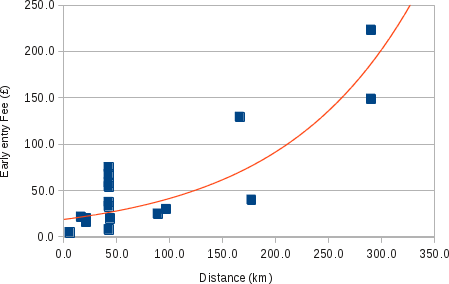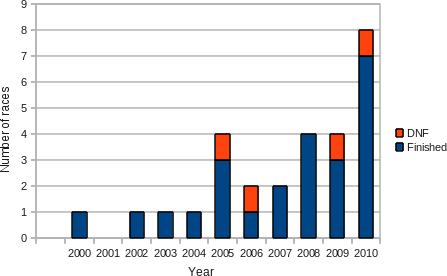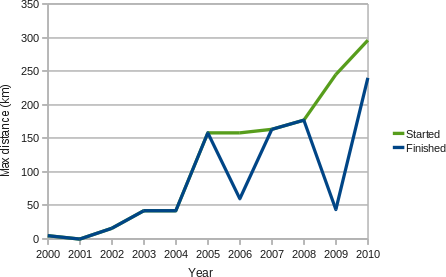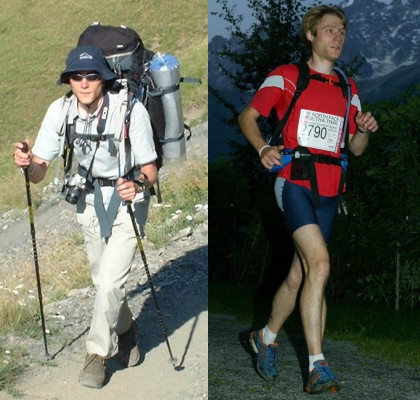Sunday, May 20 2012
Are ultrarunners slow?
By Julien on Sunday, May 20 2012, 21:59
Ultra slow
Sunday, May 20 2012
By Julien on Sunday, May 20 2012, 21:59
Thursday, April 26 2012
By Julien on Thursday, April 26 2012, 13:40
Thursday, April 5 2012
By Julien on Thursday, April 5 2012, 10:16
Wednesday, March 21 2012
By Julien on Wednesday, March 21 2012, 14:05
Tuesday, March 13 2012
By Julien on Tuesday, March 13 2012, 21:07
| Race | Distance | Entry Fee | Fee/distance |
| (km) | (£) | (£/km) | |
| Cambridge Boundary Run | 42.2 | 8.0 | 0.19 |
| Hardmoors 110 | 177.1 | 40.0 | 0.23 |
| Hardmoors 55 | 88.6 | 25.0 | 0.28 |
| Hardmoors 60 | 96.6 | 30.0 | 0.31 |
| Three Forts Marathon | 43.5 | 20.0 | 0.46 |
| PTL (3 runners) | 290.0 | 148.8 | 0.51 |
| UfDance half-marathon | 21.1 | 16.0 | 0.76 |
| PTL (2 runners) | 290.0 | 223.2 | 0.77 |
| UTMB | 166.0 | 129.4 | 0.78 |
| Belfast Marathon | 42.2 | 33.0 | 0.78 |
| Marathon des Alpes-Maritimes | 42.2 | 37.6 | 0.89 |
| Hyde Park Relays (internal) | 5.3 | 5.0 | 0.94 |
| Watford Half-Marathon | 21.1 | 20.0 | 0.95 |
| Paris Marathon | 42.2 | 54.2 | 1.29 |
| Paris-Versailles | 16.0 | 21.7 | 1.36 |
| Dublin Marathon | 42.2 | 58.4 | 1.38 |
| Copenhagen Marathon | 42.2 | 67.4 | 1.60 |
| Athens Marathon | 42.2 | 75.1 | 1.78 |
| Race | Distance | Entry Fee | Fee/distance |
| (km) | (£) | (£/km) | |
| Cambridge Boundary Run | 42.2 | 12.0 | 0.28 |
| Hardmoors 55 | 88.6 | 30.0 | 0.34 |
| Hardmoors 60 | 96.6 | 35.0 | 0.36 |
| Hardmoors 110 | 177.1 | 70.0 | 0.40 |
| PTL (3 runners) | 290.0 | 148.8 | 0.51 |
| Three Forts Marathon | 43.5 | 25.0 | 0.58 |
| PTL (2 runners) | 290.0 | 223.2 | 0.77 |
| UTMB | 166.0 | 129.4 | 0.78 |
| Belfast Marathon | 42.2 | 33.0 | 0.78 |
| Hyde Park Relays (internal) | 5.3 | 5.0 | 0.94 |
| UfDance half-marathon | 21.1 | 20.0 | 0.95 |
| Watford Half-Marathon | 21.1 | 20.0 | 0.95 |
| Marathon des Alpes-Maritimes | 42.2 | 62.6 | 1.48 |
| Copenhagen Marathon | 42.2 | 73.1 | 1.73 |
| Paris-Versailles | 16.0 | 28.4 | 1.77 |
| Dublin Marathon | 42.2 | 75.1 | 1.78 |
| Athens Marathon | 42.2 | 75.1 | 1.78 |
| Paris Marathon | 42.2 | 79.3 | 1.88 |

Sunday, March 6 2011
By Julien on Sunday, March 6 2011, 12:18
3 Forts Marathon (April 2009):I've not trained much
Marathon 06 (November 2009):given my nearly-inexistent training
Hyde Park Relays (February 2010):with a very minimal training!
Thames Source Quest (July 2010):given my current general lack of serious training
PTL (August 2010):without much training...
Marathon 06 (November 2010):given the extremely poor training regime I followed
Hyde Park Relays (February 2011):given my minimal 3-week training plan
given my lack of training


Monday, May 10 2010
By Julien on Monday, May 10 2010, 14:44
Tuesday, April 20 2010
By Julien on Tuesday, April 20 2010, 16:38
Thursday, February 11 2010
By Julien on Thursday, February 11 2010, 12:54
Friday, October 30 2009
By Julien on Friday, October 30 2009, 11:44
You don't train for a marathon, you just run it!This passage of the scriptures is summarised here.
Thursday, July 2 2009
By Julien on Thursday, July 2 2009, 11:07
Friday, November 21 2008
By Julien on Friday, November 21 2008, 16:11
Thursday, November 13 2008
By Julien on Thursday, November 13 2008, 23:47
Thursday, April 3 2008
By Julien on Thursday, April 3 2008, 19:11

Thursday, November 16 2006
By Julien on Thursday, November 16 2006, 14:50
Good afternoon,
I would like to give you my opinion about the article on cycling published in H&F News.
I'm mostly a pedestrian and definitely agree that bikes shouldn't be allowed on the pavements. However, giving a fine won't change anything; the cause of this problem must be solved. Cyclists don't ride on the pavements for the sake of annoying pedestrians. Cyclists must be given a chance to ride safely.
When you see how many cars are parked on the cycling lanes such as on Lillie road, and how dangerous it is for cyclists to overtake them, I understand why some may prefer to ride on the pavements. On top of that, these cars often generate congestion because the buses can't pass by easily. Why doesn't the police fine or even remove those cars ? They're a annoyance for other cars, for bus commuters, for cyclists and for pedestrians that have to face those cyclists. "Zero tolerance" seems to be your motto, why this doesn't apply to these cars too ?
I read Cllr Smith says disrespectfully "it is only a matter of time before [someone is] seriously injured by one of these lycra louts". He just proved himself that this has not happened yet. But tens of cyclists die on London's streets every year, and that's a fact, not a vague supposition.
Risking a £60 fine or risking to die under a car ? I think the choice is obvious ... The fine won't change anything. Clear up the cycling lanes, build new ones and cyclists won't ride on the pavements anymore.
Subsidiary question: how do you prove your bike's ownership ? I don't know many people carrying their bike receipt while commuting.
Thank you for your attention if you read so far.
Best regards,
Monday, October 2 2006
By Julien on Monday, October 2 2006, 13:24
« previous entries - page 1 of 2